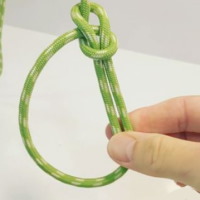Mariner’s Bowline

HOW TO TIE A BOWLINE
How to tie the Mariner’s Bowline. The “Pinch and Twist” method.
This is a great quick way of tying a bowline. You can even do this one-handed.
Before you start, just take a minute to see how the line is arranged. Then do it the same every time. In this example, the standing end and working end are running away from you. Say if you were on the dock tying up your tender.
The working (loose end) is on my right and I lay it over the standing end. Then I pinch the join with my right hand, twist clockwise and do a thumbs up 👍🏽 so the rope end pops up through the loop you have made. Practise this a few times.
Then finish off as usual, round the tree, back down the hole. Easy! Make sure the working end lies on the inside of the loop (come around the tree from right to left in this example). That’s the pinch and twist bowline, practise it and you’ll be able to do it with your eyes shut!
Other Ways of Tying a Bowline Knot
The bowline is such an important knot for sailors, so it should come as no surprise that there are many ways of tying it.
One method is not necessarily better than another, just learn a technique you are comfortable with and practise tying it from various orientations (knot facing you, knot away from you) to simulate real-world situations.
Here are 3 Ways to Tie a Bowline knot.
The History of the Bowline
This knot has been around for a long time, possibly even from Egyptian times. It was found on the rigging of an Ancient Egyptian ship belonging to Pharaoh Khufu.
The bowline was famously mentioned in John Smith’s 17th-century journals. He was one of the United States’s founding fathers. It’s often called the King of Knots.
The knot was used frequently on square-rigged ships. The bowline was the line that held the edge of a square sail towards the bow against the wind, so it needed to be strong and easy to untie.
A ship on a “taut bowline” is sailing sail close-hauled.
